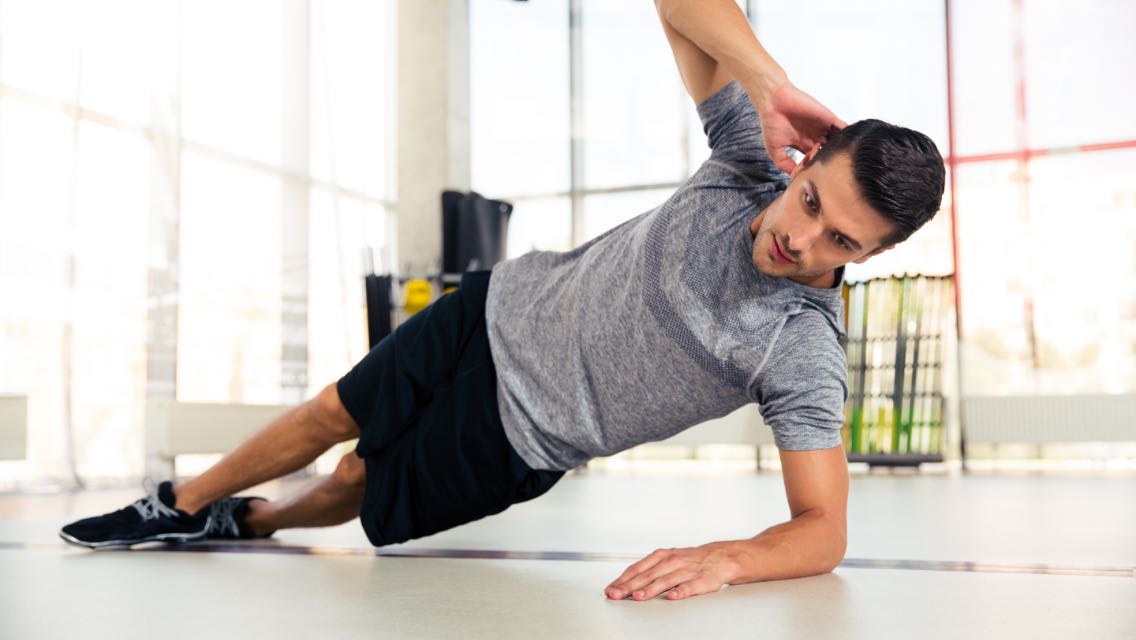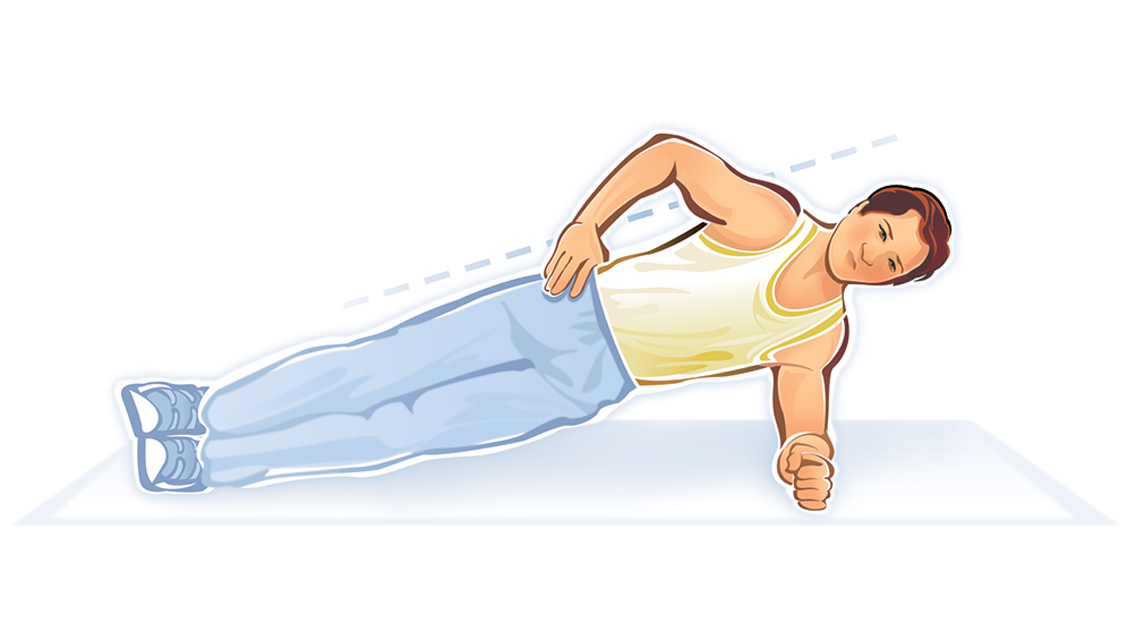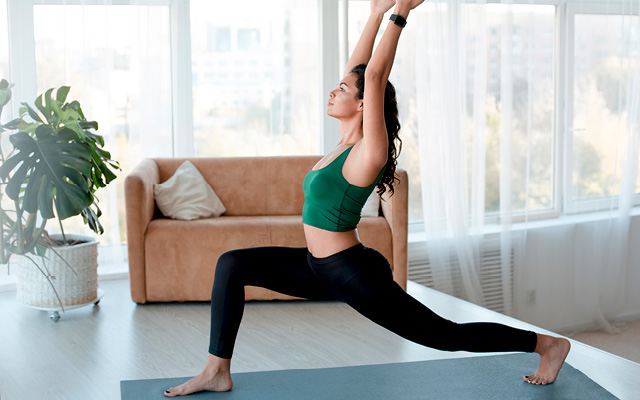Have you ever stood sideways in front of the bathroom mirror, sucked in your stomach and said to yourself: I wish I could look like that? The problem is that for most of us, those changes evaporate the minute we turn away from the looking glass. You might suppose a permanent fix takes months of a difficult abdominal routine – and, you’d be right! But if today, standing in front of the mirror, you look a lot better with your belly sucked in, you could make some quick headway by just learning a few effective isometric exercises that keep your abs engaged.
Traditional sit-ups strengthen your abdominal muscles but won’t keep your gut from spilling over your belt. That’s because sit-ups are like curling your biceps: You increase your muscle mass and strength, but between workouts your muscle fibers relax and spread out.
To combat your stomach muscles’ natural desire to relax when they’re not being used, you need to train them with an isometric routine, which is a set of exercises that tightens muscles and trains you to keep your belly taught, even when you’re away from the mirror.
Most abs exercises concentrate on the superficial rectus abdominus and the external “love handle” obliques. These are important muscles and worthy of every effort, but guess what – these aren’t the muscles that hold your stomach in. They flex the torso and look great if you’re lean enough to wear a tank top. But if you’re struggling to obtain a flat, self-supporting midsection that won’t lose shape when you stop thinking about it, you also need to condition the deeper layers of muscles that wrap around your belly and help you breathe. You need to condition the transverses abdominus and the internal obliques.
Ab Anatomy
The transversus abdominus is the deepest layer of muscle in your belly, running horizontally around your midsection like a Playtex girdle. It protects your lumbar spine and keeps you alive by working with the diaphragm to draw air into your lungs. The transversus also compresses the abs, reducing the diameter of your belly so you look good in a bathing suit.
Wrap your hands around the sides of your abdomen. Now cough. Feel those muscles griping? These are your transversus at work. If your “T” abdominus is weak, you will have a pot gut, no matter how many crunches you do. That’s because crunches primarily work the rectus abdominus, a superficial layer of muscle with the three horizontal tendon attachments – also known as the “six pack.” Problem is, this elite muscle group has only one function: flexion. It helps you bend forward but does not compress your tummy.
Second in command are the internal obliques, which are the muscles we refer to when working the “lower abs.” Internal obliques tilt the pelvis up when you’re doing crunches properly. Like the transversus abdominus, the internal obliques compress the abs. The external obliques don’t. Instead they flex and rotate your torso. They’re excellent muscles to use when you want to pick up a suitcase or look over your shoulder, but they’re only marginally useful if you want to create a narrow, tapered waist.
Since muscle groups always work together, any abs routine works just about every abdominal muscle you have. But some exercises challenge specific muscles more than others. The system outlined here is designed to provide you with the best abdominal squeeze available by focusing on the transversus and internal obliques. It will train you to sustain tension and strengthen your muscles in a contracted state. For 24 hours after working this routine, your stomach will feel taught and strong. Isometrically trained abs will help you maintain a good svelte posture while you read, walk, work or play.
Partner Core Exercises
Working with a partner is best for isometric training because you labor against an opposing force. But there is one isometric exercise you should do alone, and if you’re truly serious about having great looking abs, it’s the first one you’ll have to commit to
Vigilant Abs
At any time of the day, no matter what you’re doing, become aware of your posture and the position of your abs.
- Straighten up, suck in your stomach as tight as you can, hold it there for a moment, then relax just enough so that you can breathe comfortably.
- Hold the pose as long as you can keep your mind on it.
After a while, you’ll get distracted – but the next time you remember, practice the sequence all over again. Working this simple isometric routine several times every day will do more to improve your appearance – and quickly – than any other exercise on the planet.
Rolling Abs
Rolling Abs are very difficult to do but will become one of your favorites, because the benefits are obvious and immediate.
- Lie on your back, with your partner standing at your feet, and curl your knees over your chest so that your calves are parallel to the floor.
- Place your hands loosely beside your ears (as you would for crunches), bring your elbows up and press them against your knees.
- While you maintain this posture, which is very similar to the upward movement of a standard crunch, your partner should grasp your knees and begin rolling you, very slowly, toward himself until your feet almost touch the ground.
- Then they should roll you back, slowly, until the small of your back is flat on the mat.
- Exhale as you come up; take a quick breath at the top.
Tips: Your knees should be touching. Your elbows firmly planted on your knees. The rocking action should be fluid, without a single rest stop. A steady and deliberate motion forces your stomach to stay rigid during the entire exercise, stressing upper and lower abs, targeting different muscle fibers. All you have to do is hold the pose.
Sound simple? If you can do more than 15 you are in good abdominal shape. Even trained athletes have trouble surpassing 25 repetitions.
Make It Harder: Instead of curling your legs over your chest, keep your hips as close to 90 degrees as possible, as shown below.
Boxer Sit-Ups
Here is a knockout abdominal exercise from the world of prizefighters and champions who use it to prepare their abs for combat.
- Lie on your back, with your partner standing about one foot behind your head.
- Grab your partner’s ankles tightly, just above the heel, and extend your legs perpendicular to the floor. The soles of your feet should be parallel to the ceiling. Keep only the slightest bend in your knees and allow your partner to grab your feet.
- As you tighten your abs, your partner should toss your legs away from himself with a smooth but firm push. It should be strong enough to cast your legs down to a 45-degree angle before you can recover. Resist the thrust.
- Spring back as soon as possible; bring your feet up, legs straight, right back into your partner’s hands for the next push. These are called midrange swings, or pushdowns.
You can use this same technique to work the obliques by having your partner push your legs down diagonally, at a 60-degree angle, both right and left. Your partner should alternate sides without warning, so that you constantly have to work, unable to anticipate the next move.
Basic Tip: Your partner should vary the speed and rhythm of the thrusts so that you are not able to assist the movement.
Make It Harder: Try the routine with your eyes closed, so that you can’t relax into a predictable rhythm.
Variation Reverse Sit-Ups
In the strictest sense, this variation on the reverse sit-up is not an isometric exercise, because it doesn’t require you to work against an opposing force. But it applies the basic isometric principle of uninterrupted tension, forcing the abs to clamp like a vise, without pause or relaxation.
- Lay on your back with your knees bent and your feet flat on the floor.
- Cross your arms in front of your chest and have your partner hold onto your feet while you raise your torso upward.
- Immediately lower your torso, slowly and deliberately, as if you were completing a traditional sit-up. Sound familiar so far? Here’s the twist: During your slow descent have your partner call “Up!” at random points, so that you won’t anticipate the movement. Come up as soon as you hear the command, without stopping, and start back down immediately after your elbows touch your knees.
- Repeat the sequence without interruption.
Basic Tip: Sometimes your partner should call “Up!” after you travel a short distance, sometimes when you are just a few inches from the floor. This will keep your stomach muscles tense during the whole drill, and will add a new, exhausting twist to this tried-and-true exercise.
Make It Tougher: Hold a barbell plate on your chest.
Solo Performance
Do the following solo iso-ab exercises as a warm-up and cool-down before and after the intense partner-abs sequence described on the previous page. You should do the complete sequence three times a week, but do the following solo iso-abs every day.
Anterior Plank
- Get on your hands and knees. Then place your forearms on the floor and extend your legs, holding your torso off the floor on toes and forearms, like a modified pushup position.
- Make sure your back is straight.
- Inhale normally, and then exhale slowly through pursed lips.
- Force the air out, fighting against the resistance of your lips. Concentrate on tightening your inner abs.
- Once you have emptied your lungs, hold the exhalation a few seconds while keeping your stomach flat, as if the muscles were cramping.
- Then inhale quickly, and repeat the deliberate, focused, gut-wrenching exhalation. Think of each exhalation as a slow negative, lasting eight to 10 seconds. Sustain this exercise for two minutes.
The Anterior Plank works the lower abs.
Lateral Plank
- Lay on your right side.
- Prop yourself up on your right elbow.
- Place your left hand on your left hip.
- Raise your hips off the floor, resting on your elbow and the side of your right foot. Make sure your torso forms a straight diagonal.
- Now begin breathing as described above, concentrating on the right inner oblique.
- Do this exercise for one minute, and then repeat on your left side.
Posterior Plank
- Lay on your back, with your arms at your sides.
- Keeping your knees straight, lift your feet about six inches off the floor.
- Then raise your back, bringing your head approximately six inches off the floor. You’ll be in a wide “V” position, eyes in line with your toes.
- Rest your hands on your thighs. Breathe as described above. You’ll notice that this variation works the upper abs.
- It’s a difficult position, but try to hold it for two minutes.
Get Your Abs On!
Sticking to boring old crunches is so passé. If you want new-and-improved mid-section results, you need to get into a new-and-improved abdominal routine. Try this on for size…
| Exercise | Repetitions | Sets |
| Warm-Up: Solo Iso-Abs instructions | See “ |
|
| Rolling Abs | 10–15 | 2 |
| Boxer Sit-Ups | 35 | 1 |
| Variation Reverse Sit-Ups | 10 | 2 |
| Cool-Down: Solo Iso-Abs instructions | See “Solo Performance,” above |
Allow 15 to 20 seconds of rest between sets. Train three times a week. Do the solo iso-abs every day.
Should You Ditch the Weight Belt?
For stability, your lower back relies on the fluid ball of compression provided by your transversus. A weight belt provides this girdle action without recruiting your muscles. In studies with baggage handlers at airports, the handlers who wore belts reported more injuries than those who didn’t. One of the best belly-cinching exercises you can do is lift weights with a tight midsection, sphincter pulled taught, transversus bearing down on a full breath as you lift. Exhale past the sticking point of the exercise and repeat this until it becomes a habit.
This article originally appeared as “Every-Ready Abs.”




This Post Has 0 Comments